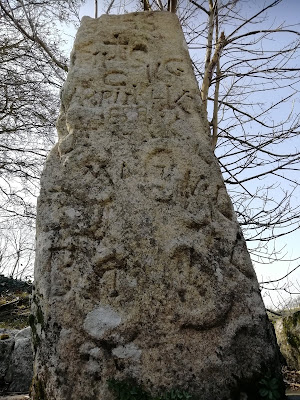Hidden away in county Carlow is the tiny hamlet of Clonmore which was an important early Christian site.
It's about 17 Kms from Tullow or 30 Kms from Carlow town and a wonderful place to visit, full of natural beauty and tranquility.
What I really like about places like Clonmore is that more often than not they aren't awash with crowds of visitors so they are really peaceful places to visit.
No queues, no entry fees, no crowds and no traffic jams, just nature and the historical environment.
Often you come across places like this quite by accident just wandering around in rural Ireland.
In the 6th Century Saint Mogue (Maedoc) founded a Monastery here and the remains and evidence of a strong ecclesiastical tradition are to be found throughout the area.
I spent a couple of hours in this tiny area but if time had permitted I could have relaxed here for the day enjoying the sights and sounds around me.
Saint Mogue's High Cross is a large undecorated granite High Cross situated in the grounds of Saint Mogue's Church of Ireland.
There is a huge Bullaun stone by the bridge over the stream which runs through Clonmore and it was probably moved to its present location from the nearby fields. There are three big depressions in the Bullaun and a smaller fourth depression in it as well.
The Cemetery contains a huge amount of Christian Cross Slabs, both recumbent and upright.
I think these Cross Slabs may probably date from the mid Christian to late medieval period but not being an expert I can't be sure of the dates for them.
One stone in particular has a date from the 1800's marked on it and several words in Irish as well as many unusual markings which actually looked a little like Bronze Age cup and ring marks although I have no idea what those markings actually are and they are not recorded as such.
There is also the head of a huge High Cross included in a group of Slabs gathered together and the cross it came from must have been very large and impressive when it was originally in one piece.
A lot of the smaller Cross Slabs at Clonmore are very similar to Cross Slabs I have seen in Ballymore Eustace and other areas in Wicklow and Carlow.
There's an Ogham Stone here as well, pictured above. Ogham was an old Irish 20 letter alphabet originating around c. 350 AD and consisted of groups of linear slash marks.
It's chiefly found in Ireland but also in parts of Britain and very occasionally uses other languages other than old Irish or Gaelic.
The Ogham inscription on the stone isn't visible any more and has now been worn away, or at the least my eyes couldn't make it out if it's still on the stone.
There are several bits and pieces of ancient masonry work scattered around the site and something which looked like a water trough though probably isn't, yet still very interesting to look at.
There's also an upright Grave Stone which looks like it's made from Schist and has a hole in the middle worn or cut through it and I couldn't but wonder did it have an association with a later local tradition of some sort.
There's a beautifully maintained little Well, Saint Mogue's Holy Well and a small pond and manicured grassy area which are really nice to relax at beside the Church.
Clonmore Castle is nearby and a 2 minute walk from the Church. It is a large Anglo Norman Castle ruin mooted as originally dating from the 12th or 13th Cty with some later modifications.
I don't know a huge amount about Castles so I'll leave it's dating to the experts. I believe there are no records of it's initial construction. The structure would have been quite compex and has numerous, in technical parlance, "Snazzy" windows so it looks too well designed to be a 12th Cty construction although they could have been added later I suppose.
The Castle would benefit from conservation work to ensure no further damage is caused by the elements and weathering.
It would be nice to think it would still be there a century from now rather than it fell down over the intervening years.
As a place to visit, enjoy and explore, Clonmore ranks highly in my book and no doubt when things get going again in 2020 I look forward another visit.
Coordinates to Clonmore :
52°49'38.2"N 6°34'11.5"W
52.827265, -6.569846
On a side note I've used the term cemetery in this post where really to be true to fashion the preferred reference to a burial place attached to a church is graveyard. Likewise I often use Portal Dolmen when the proper usage is Portal Tomb....Hopefully it's not a hanging offence.
Keep the wheels turning.
On a side note I've used the term cemetery in this post where really to be true to fashion the preferred reference to a burial place attached to a church is graveyard. Likewise I often use Portal Dolmen when the proper usage is Portal Tomb....Hopefully it's not a hanging offence.
Keep the wheels turning.
















